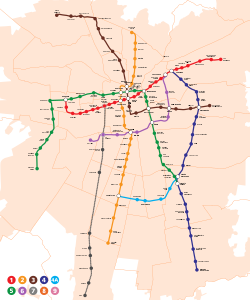Santiago Metro
 |
|||

NS 93 train on the Santiago Metro
|
|||
| Overview | |||
|---|---|---|---|
| Native name | Metro de Santiago | ||
| Locale | Santiago, Chile | ||
| Transit type | Rapid transit | ||
| Number of lines | 5 | ||
| Number of stations | 108 | ||
| Daily ridership | 2.4 million | ||
| Annual ridership | 648.7 million (2012) | ||
| Website | Metro de Santiago | ||
| Operation | |||
| Began operation | 15 September 1975 | ||
| Operator(s) | Metro S.A. | ||
| Technical | |||
| System length | 103 km (64 mi) | ||
| Track gauge | 1,435 mm (4 ft 8 1⁄2 in) standard gauge | ||
| Electrification | 750 V DC guide bars | ||
|
|||
The Santiago Metro (Spanish: Metro de Santiago) is the underground railway network serving the city of Santiago, Chile. This network is one of the most modern in Latin America, being the second largest following the Mexico City Metro, and it is 7th in frequency worldwide. It currently has five lines, 108 stations, and 103 kilometres (64.0 mi) of revenue route. This service is administered by the state-owned Metro S.A. and is the first of three urban railway systems in Chile, along with the Biotrén of Concepción (1999) and Merval of Valparaíso (2005).
The Santiago Metro carries around 2.5 million passengers every day. This figure represents an increase of more than a million passengers per day compared to figures prior to 2007, when the ambitious Transantiago project was launched, in which the metro plays an important role in the public transport system serving the city. Its highest passenger peak was reached on 31 October 2012, reaching 2,780,666 passengers.
Along with its five operational lines, two new lines are being built – Line 6, connecting Cerrillos with Providencia with 11 new stations and an extension of 15.3 kilometres was announced in late 2009 and ratified in 2011, while the long delayed Line 3 will connect Huechuraba and La Reina with an extension of 21.7 kilometres and 19 new stations. Investment for the construction of these extensions is of nearly US$2.7bn and is expected to reach 120 million annual trips. In 2014, it was announced that Line 3 would be expanded even further towards the northwest, reaching Quilicura, and Line 2 would be expanded further south towards El Bosque and San Bernardo, adding 7 new stations to the network and an additional 8.8 kilometres of tracks by 2020. It was also announced that analytical studies would begin for the construction of a new line, Line 7 to cross the city from east to west to relieve congestion on Line 1.
...
Wikipedia

